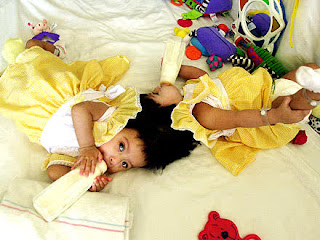"I'm learning synchronized swimming," Josie says, "and I really like it."
It's hard to fathom that nine years ago, Josie, born Maria de Jesus Quiej Alvarez, was lying in an intensive care unit, clinging to life after surviving a 23-hour surgery at UCLA's Mattel Children's Hospital that separated the Guatemalan 1-year-old from her conjoined twin sister, Maria Teresa.
Famously known as "the Two Marias," they were craniopagus twins – those who are fused at the tops of their heads – accounting for just 2 percent of conjoined cases worldwide.
Their separation surgery made international headlines and required support from Mending Kids International, then a chapter of Healing the Children, which includes such benefactors Mel and Robyn Gibson, who were on hand Saturday when Josie and Teresa celebrated the Hawaiian-themed birthday at a home in Malibu.
"It's incredible," Mel told PEOPLE. "Conjoined twins joined at the head don't normally get to see age 10. It's special seeing them doing as well as they are, and doing it with such joy. But it's not like they don't have hurdles to hop, they do."
Just 10 months after the Aug. 6, 2002 surgery, the girls were airlifted on a donated private jet back from Guatemala for emergency treatment. Teresa had contracted deadly meningitis, and spent five months in 2003 in and out of a coma. Today, she is unable to walk and cannot speak.
Josie fared better but was suffering from grand mal seizures and came down with hydrocephalus, fluid build up on the brain.
The girls have spent the past eight years in and out of the hospital and today maintain a rigorous regimen of physical and occupational therapy, including several months a year at an ambulatory care center in Michigan for Josie.
Their medical needs, primarily covered by insurance, convinced their parents, Wenseslao and Lety Alvarez, to request that the girls remain in the United States. The twins are under the daily care of guardians Jenny Hull, 40, who has custody of Josie, and Florie and Werner Chahas, a Guatemalan couple with four children of their own, who watch over Teresa.
Each Sunday, Josie and Teresa call their parents in Belem, a small village outside Guatemala City, and they see them at least twice a year when they visit Los Angeles at the Chahas and Hull's own expense, Hull says.
"We want them to know how loved they are and to keep the connection to their daughters," she says.
The girls are also keeping busy. Teresa is enrolled at a special needs school and especially enjoys music and art. Josie, who uses a walker, attends a public school and takes care of her two pet rabbits.
"I'm working hard," says Josie, beaming. "My legs get tired but I feel stronger; I want to walk with my friends and I can't do it. I'm still learning."
A Deep Emotional, Physical Bond
The girls live 50 miles apart but see each other about four times a week, counting therapy appointments. On Sundays, they swim, play at the park, dress up dolls and watch TV. Josie says she loves making her sister laugh.
"I blow in her face and it makes her smile and I tickle her a lot," she says.
Hull, an independent distributor of AmeriSciences products through her company, Wellnessmove.com, says when the girls lie down next to each other, they often resume the position they held in their mother's womb and their first year of life.
"Their heads come together," says Hull. "Teresa just lights up when they do that."
Even when they're apart, says Werner, they are inexplicably connected.
"We have had many situations when Teresa is sick and we find out Josie is also having a bad day, and vice versa," says Werner, a church pastor who was a physician in Guatemala before his family emigrated to the U.S. in the mid 1990s.




One may have one soul,even if the baby has two brains and two spines.And only one heart.Medical science has to face sophisticated scientific questions to be remedied and the ethics will have to face new questions.God,direct the hands of doctors for noble deeds.Every problem has to be faced and remedied.Then only man can go forward.
ReplyDelete